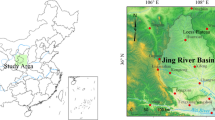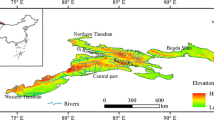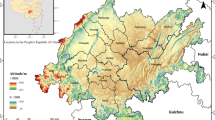Abstract
The spatiotemporal variation and driving force of the Normalized Difference Vegetation Index (NDVI) are helpful to ecological environment protection and natural resource management. Using the Sen and Mann–Kendall methods, Hurt index, and the Geodetector, this study investigated the temporal and spatial changes and driving forces of NDVI during 1982–2015. The results showed that (1) From 1982 to 2015, the high vegetation coverage was mainly distributed in the Qinling Mountains and the Daba Mountains, while the low vegetation coverage was in high altitude areas in the west, low altitude in the east, and the Hanjiang River valley. (2) NDVI in the Qinba Mountains increased continuously accounting for 81.1%, with 68% showing slow growth. In the future, only 37.8% of the vegetation will have significant change. The area of vegetation increase will be greater than the area of decrease. (3) NDVI increased firstly and then decreased with the increase of altitude, reaching the maximum value at 1100 m. NDVI showed a trend of fluctuating growth. It reached the maximum value of 0.86 in 2015. (4) Through the Geodetector, the main factors affecting NDVI were natural factors mainly including rainfall, soil type, and digital elevation model (DEM), while human activities, including population density, had little influence on NDVI. Natural environment factors and human activities together had a greater impact on the spatial distribution of NDVI. This study could provide help for the sustainable development of the natural environment in the Qinba Mountains.








Similar content being viewed by others
Data availability
The GIMM3g datasets used to support the finding of this study were derived from the National Oceanic and Atmospheric Administration (NOAA) Advanced Very High Resolution Radiometer (AVHRR) (https://www.noaa.gov/research). The climate datasets, population density data, GDP data, and land use type were acquired from the Resource and Environment Science and Data Center (http://www.resdc.cn/). SRTM 90 m Digital Elevation Model (DEM) products come from Geospatial Data Cloud (http://www.gscloud.cn/).
References
Ali S, Henchiri M, Sha Z, Wilson K, Yun B (2020) A time series of land cover maps of south Asia from 2001 to 2015 generated using AVHRR GIMMS NDVI3G data. Environ Sci Pollut Res 27(3):8433–8442
Barati S, Rayegani B, Saati M (2011) Comparison the accuracies of different spectral indices for estimation of vegetation cover fraction in sparse vegetated areas. Egypt J Remote Sens Space Sci 14(1):49–56
Bashir B, Cao CX, Naeem S, Joharestani MZ, Bo X (2020) Spatio-temporal vegetation dynamic and persistence under climatic and anthropogenic factors. Remote Sens 12(16):1264–1293
Chen CN, Zhu LQ, Tian L, Li XG (2019) Spatial-temporal changes in vegetation characteristics and climate in the Qinling-Daba Mountains. Acta Ecol Sin 39(9):3257–3266
Chen T, Xia J, Zou L (2020) Quantifying the influences of natural factors and human activities on NDVI Change in the Hanjing River Basin, China. Remote Sens 12(22):3780–3801
Cui ZZ, Ma C, Huang SS (2020) Growth period trend analysis both Tritium aestivum L. and Zea mays L. in Eastern Henan Province: case study of NDVI3g (1982–2013) in Yongcheng and Xiayi experiment areas. IOP Conf Ser: Earth Environ Sci 467(1):12213–12220
Dong Y, Yin DQ, Li Y, Yan TL, Wang HS (2020) Spatio-temporal patterns of vegetation change and driving forces in the Loess Plateau. J China Agricult Univ 25(8):120–131
Eisfelder C, Kuenzer C, Dech S (2012) Derivation of biomass information for semi-arid areas using remote-sensing data. Int J Remote Sens 33(9):2937–2984
Gitelson A, Kaufman YJ, Stark R (2002) Novel algorithms for remote estimation of vegetation fraction. Remote Sens Environ 80(1):76–87
Guan QY, Yang LQ, Guan WQ, Wang FF, Liu ZY, Xu CQ (2019) Assessing vegetation response to climatic variations and human activities: spatiotemporal NDVI variations in the HeXi Corridor and surrounding areas from 2000 to 2010. Theoret Appl Climatol 18:2437–2438
Gutman G, Ignatov A (1998) The derivation of the green vegetation fraction from NOAA/AVHRR data for use in numerical weather prediction models. Int J Remote Sens 19(8):1533–1543
Hamed KH (2009) Exact distribution of the Mann-Kendall trend test statistic for persistent data. J Hydrol 365(1–2):86–94
Hao HM, Hao YL, Ren ZY (2011) Analysis on dynamic and pattern of land use/cover change in Guanzhong area. Sci Agric Sin 44(21):4525–4536
Hu XX, Di BF, Yuan Y, Huang J, Zhang M (2020) Response characteristics of vegetation dynamics with ecological construction project: a case study in the upper reaches of the Yangtze River Basin. Resour Environ Yangtze Basin 25(8):1264–1272
Jiang RG, Xie JC, He HL, Kuo CC, Zhu JW, Yang MX (2016) Spatiotemporal variability and predictability of Normalized Difference Vegetation Index (NDVI) in Alberta, Canada. Int J Biometeorol 60(9):1389–1403
Kawabata A, Ichii K, Yamaguchi Y (2001) Global monitoring of interannual changes in vegetation activities using NDVI and its relationships to temperature and precipitation. Int J Remote Sens 22(7):1377–1382
Li SS, Yan JP, Wan J (2012) Temporal and spatial variation characteristics of vegetation cover in Shaanxi Gansu Ningxia Loess Plateau in recent 10 years. Acta Geogrephica Sin 67(7):960–970
Liu YL, Wang Q, Bi JZ, Zhang MM, Xing QG, Shi P (2010) The analysis of NDVI trends in the coastal zone based on Mann-Kendall test: a case in the Jiaodong Peninsula. Acta Oceanol Sin 32(3):79–87
Liu XF, Zhu XF, Pan YZ, Li SS, Ma YQ, Juan N (2016) Vegetation dynamics in Qinling-Daba Mountains in relation to climate factors between 2000 and 2014. J Geog Sci 26(1):45–58
Liu XX, Tian ZX, Zhang AB, Zhao AZ, Liu HX (2019) Impacts of climate on spatiotemporal variations in vegetation NDVI from 1982–2015 in Inner Mongolia, China. Sustainability 11(3):768–790
Meng Z, Li XJ, Gong HL, Qu YT (2015) NDVI change and climate factor driving analysis in Beijing Tianjin Hebei region. J Geo-Inform Sci 17(8):1001–1007
Meng M, Niu Z, Ma C, Tian HF, Pei J (2018) Qinghai-tibet plateau NDVI change trend and its response to climate. J Soil Water Conserv Res 25(3):360–365
Miao CY, Yang L, Chen HX, Gao Y (2012) The vegetation cover dynamics (1982–2006) in different erosion regions of the Yellow River Basin, China. Land Degrad Dev 23(1):62–71
Peng WF, Wang GJ, Zhou JM, Xu XL, Luo HL (2016) Dynamic monitoring of fractional vegetation cover along Minjiang River from Wenchuan County to Dujiangyan City using multi-temporal Landsat 5 and 8 images. Acta Ecol Sin 36(7):1975–1988
Piao SL, Fang JY, Zhou LM, Guo QH, Heenderson M, Ji W, Li Y, Tao S (2003) Interannual variations of monthly and seasonal normalized difference vegetation index (NDVI) in China from 1982 to 1999. J Geophys Res 108:4401–4413
Piao SL, Fang JY, Ji W, Guo QH, Ke JH, Tao S (2004) Variation in a satellite-based vegetation index in relation to climate in China. J Veg Sci 15(2):219–226
Qin F, Zhang Y, Yan JF, Zhang Y, Li CQ (2020) Analysis on the spatial and temporal characteristics and driving forces of land use/cover change in Chenggong district. China Resour Compr Utiliz 38(9):35–40
Running SW, Nemani RR, Heinsch FA, Zhao MS, Hashimoto H (2004) A continuous satellite-derived measure of global terrestrial primary production. Bioscience 54(6):547–560
Shi PJ, Kong F, Fang JY (2014) Spatio-temporal patterns of China decadal storm rainfall. Sci Geogr Sin 34(11):1281–1290
Tang XJ, Chen XX (2018) A study on water resources exploitation and protection in Qinling-Dabashan Mountain area. J Southwest Petrol Univ: Soc Sci Ed 20(2):39–46
Tao S, Kuang TT, Peng WP, Wang GJ (2020) Analyzing the spatio-temporal variation and drivers of NDVI in upper reaches of the Yangtze River from 2000 to 2015: a case study of Yibin City. Acta Ecol Sin 40(14):5029–5043
Wang JF, Xu CD (2017) Geodetector: principle and prospective. Acta Geogr Sin 72(1):117–133
Wang ZX, Liu C, Chen WP, Lin X (2006) Preliminary comparison between MODIS enhanced vegetation index EVI and NDVI. Geomat Inform Sci Wuhan Univ 31(5):407–410
Wang DL, Liu WP, Huang XY (2013) Trend analysis in vegetation cover in Beijing based on Sen + Mann-Kendall method. Comput Eng Appl 49(5):13–17
Wang MY, Fu J, Wu ZT, Pang ZG (2020) Spatiotemporal variation of NDVI in the vegetation growing season in the source region of the Yellow River, China. Int J Geo-Inform 9(4):282–299
Wen ZF, Wu SJ, Chen JL (2017) NDVI indicated long-term interannual changes in vegetation activities and their responses to climatic and anthropogenic factors in the three gorges reservoir region, China. Sci Total Environ 574:947–959
Wu LN, Yang ST, Liu XY, Luo Y, Zhou X, Zhou H (2014) Response analysis of land use change to the degree of human activities in Beiluo River basin since 1976. Acta Geogr Sin 69(1):54–63
Xu GH, Ge QS, Gong P, Fang XQ (2013) Global change and human sustainable development: challenges and countermeasures. Sci Chin Press 58(21):2100–2106
Yue SR, Zhou JY, Hu XF, Meng FJ (2020) Study on driving factors and spatial-temporal evolution of vegetation coverage in Xinjiang from 2000 to 2018. J Tarim Univ 32(6):97–105
Zhang XZ, Dai JH, Ge QS (2013) Variation in vegetation greenness in spring across eastern China during 1982–2006. J Geog Sci 23(1):45–56
Zhang SY, Nie Y, Zhang HY, Li YL, Han YD, Liu XH, Wang B (2020) Spatiotemporal variation of vegetation NDVI and its driving forces in Inner Mongolia based on Geodetector. Acta Agrestia Sin 28(5):1461–1471
Zhao AZ, Zhang AB, Lu CY, Wang DL, Wang HF (2017) Spatiotemporal variation of vegetation coverage before and after implementation of Grain for Green Program in Loess Plateau, China. Ecol Eng 104:13–22
Acknowledgements
We would like to thank the anonymous reviewers and editors for their valuable comments and suggestions.
Funding
This research was supported by the Integrated Scientific Investigation of the North–South Transitional Zone of China (Grant No. 2017FY100904).
Author information
Authors and Affiliations
Contributions
Conceptualization, H.Y.; methodology, H.Y., Z.-Y.R., L-Y.L, and J-L.P.; writing—original draft preparation, Z.-Y.R.; and writing—review and editing, H.Y. All authors have read and agreed to the published version of the manuscript.
Corresponding author
Ethics declarations
Ethics approval and consent to participate
Not applicable.
Consent for publication
No applicable.
Competing interests
The authors declare no competing interests.
Additional information
Responsible Editor: Philippe Garrigues
Publisher's note
Springer Nature remains neutral with regard to jurisdictional claims in published maps and institutional affiliations.
Rights and permissions
About this article
Cite this article
Zhang, Y., He, Y., Li, Y. et al. Spatiotemporal variation and driving forces of NDVI from 1982 to 2015 in the Qinba Mountains, China. Environ Sci Pollut Res 29, 52277–52288 (2022). https://doi.org/10.1007/s11356-022-19502-6
Received:
Accepted:
Published:
Issue Date:
DOI: https://doi.org/10.1007/s11356-022-19502-6




